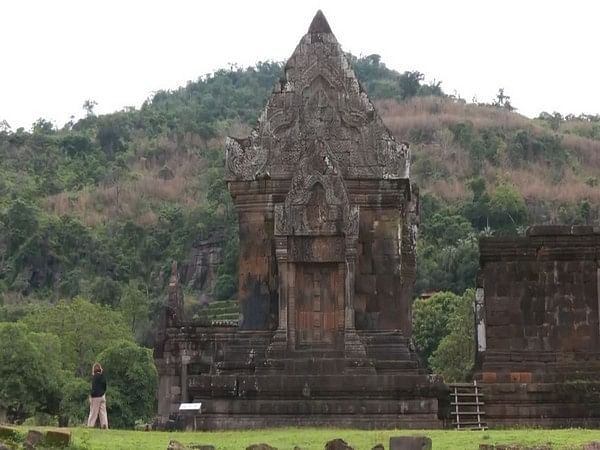Vientiane [Laos], July 3 (ANI): In the deepening of India-Laos ties, apart from years of bilateral engagements, the two nations’ shared cultural linkages and heritage have played a significant role.
In order to foster cultural ties further with Laos, India’s role in restoring the Vat Phou UNESCO World Heritage site is seen as an exemplary move.
It is pertinent to know that India and Laos share “longstanding, friendly and mutually supportive relations,” and the restoration work of the ancient architecture of Van Phou in Pakse, Laos would add more to it. India’s ASI (Archaeological Survey of India) leads the conservation project here.
The Vat Phou Temple complex is a well-preserved planned landscape more than 1,000 years old.

UNESCO describes it as a temple complex that was “shaped” to express the Hindu vision of the relationship between nature and humanity. Moreover, two planned cities on the banks of the Mekong River are also part of the site, as well as Phou Kao Mountain.
As a whole, it represents a development ranging from the 5th to 15th centuries, mainly associated with the Khmer Empire.
‘Vat Phou’ is an ancient Hindu temple, for the restoration of which, a team from the Archaeological Survey of India (ASI) from India came in 2005 and inspected the site. The actual process of conservation was started later in 2009 physically at the site.
“A team from the Archaeological Survey of India (ASI) from India came in 2005, and they inspected the site. And then, an MoU was signed between India and the Lao PDR government in 2007 on the subject of the temple’s conservation, and in 2009, actual conservation started physically on site,” Ashok Kumar, lead ASI conservation team of Vat Phou told ANI.
“The phase one of conservation was from 2007 to 2017, which concluded. And soon after, the second phase was held from 2018 to 2028,” he said.

The Vat Phou temple holds a major significance for various reasons in Laos, as the Southeast Asian country holds a lot of similarities with Indian culture and heritage, and so does the ancient structure.
“It is a Hindu temple, an ancient temple of Lord Shiva…you will find the Hindu mythology scriptures on the structures at the site. It includes scriptures, and rock-cut images of Brahma, Vishnu, and Mahesh. You will find the antiquity, images of Hanuman…” Kumar further said.
“Hindu dharma and mythology came here when there was no dharma here; it gave the place the culture. And after that, in 2014, when Buddhism came here, that’s when the culture turned into a Buddhist one,” he added.

The views of India, and Laos converge on many issues of mutual interest in international forums. The two nations enjoy warm and friendly ties characterised by the exchange of regular visits at all levels.
“Vat Phou is a Hindu temple, that was first seen in the 5th century, but its original temple construction was replaced by a new one in the 11th-12th century. And, this temple is dedicated to Hinduism. In the 14th century, it changed to Buddhism,” the Deputy Director of the Ministry of Culture and Head of Vat Phou World Heritage Site Division, Amphol Sengphachanh told ANI, as he lauded the cultural ties between India and Laos.

Meanwhile, throwing some light on how the restoration work is carried out, Yogesh Raja, a Senior Conservationist ASI, for Vat Phou Laos said, “When the ASI came here for the first time, every year we worked here for 6-7 months, and in the rainy season it is very difficult to work here…For the last 15 years, the team has been working here, for a 6-7 months period…”
He further stated it is the quality of work that matters the most, especially if it is a World Heritage site.
“Being a UNESCO world heritage site, it is not the quantity of work, one has to focus on, but the quality of it, as we have to maintain the integrity of the structure, as maximum as possible…huge volume of work is still before us,” he said.

Notably, India shares age-old civilisational ties best symbolised by the relic of the Buddha encased in the That Luang Stupa, the national emblem of Lao PDR, and the Vat Phou Temple Complex.
“Laos shares a lot of similarities with Indian culture and heritage, so whatever the sculptures, design and structures, slight deviation is there, but it is central and southern India like culture…government of India is supporting this project so that this temple can last for another several centuries,” Yogesh Raja added.

Laos remains landlocked with China as its northern neighbour, and Vietnam lies to the country’s northeast and east. South of Laos is Cambodia while Thailand is on its west and Myanmar lies on its northwest.
Laos is a part of India’s extended neighbourhood as only Myanmar separates Laos from India’s North East. According to the MEA, “As the Indian presence grows and the success stories become more, India-Laos relations in different spheres are likely to grow.” (ANI)
This report is auto-generated from ANI news service. ThePrint holds no responsibility for its content.



